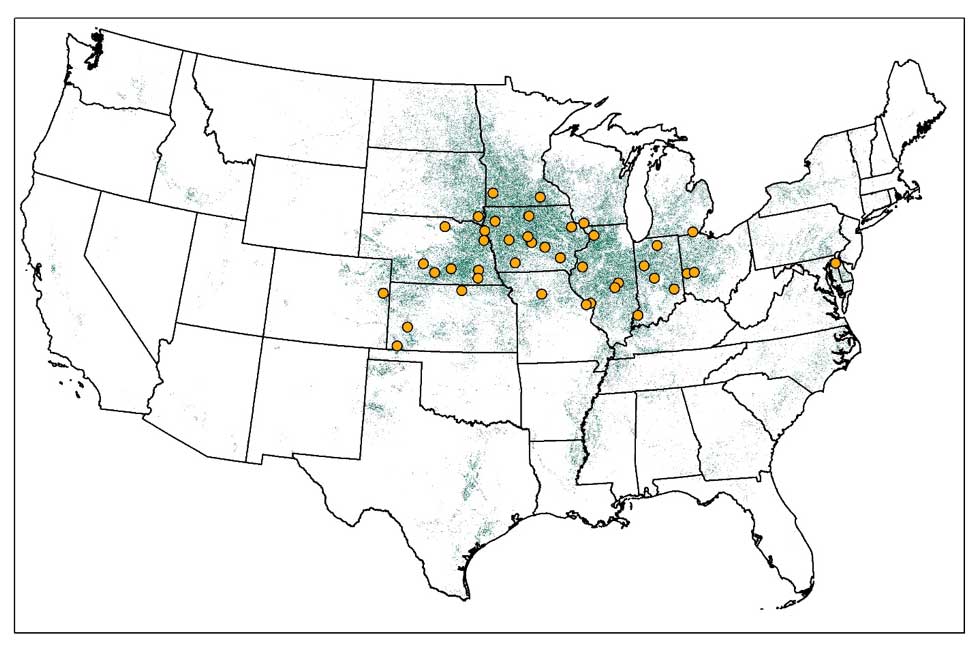Multi-Institutional Research Collaboration Aims to Improve Sustainability of Corn Production
ST. LOUIS, MO, June 10, 2021 –The Foundation for Food & Agriculture Research (FFAR) awarded a $2,044,214 grant to Iowa State University, the Donald Danforth Plant Science Center and the Leopold Center for Sustainable Agriculture, Purdue University to evaluate how maize breeding, field management and environment affect the production and sustainability of the corn industry. Iowa State and Bayer Crop Science provided matching funds for a $4,089,857 total investment.
Maize breeding programs have increased corn yields over the years by altering plant characteristics (traits). Yet, our knowledge on which traits have been changed is limited while their impact on sustainability is relatively unknown. The lack of this information compromises our ability to accurately predict future yields and sustainability trajectories because plant traits are important inputs in crop models, the primary tool for climate change assessments.
“To sustain a growing global population, we need current, accurate information about crop performance,” said FFAR Executive Director Dr. Sally Rockey. “Evaluating the relationship between productivity and sustainability in our corn programs will enhance farmer profitability and resiliency while enhancing human health and well-being."
Led by Dr. Sotirios Archontoulis, Iowa State University researchers are examining corn hybrid characteristics at an unprecedented scale to analyze yield trends in the US Corn Belt, which includes most of the Midwest.
“Our role is to evaluate impacts that decades of corn breeding for yield under high fertilizer inputs had on the structure and function of root systems, with the goal of improving their efficiency toward sustainable agriculture goals,” said Christopher Topp, PhD, associate member, Danforth Center.
Over the course of three years, researchers are collecting data from 40 locations per year, covering a range of environments and production situations across the Corn Belt. Using advanced analytics including simulation modeling and machine learning, researchers are evaluating plant, root, grain and resource use efficiency traits. This analysis will help researchers determine the impact of plant breeding on sustainability and rank the importance of different plant traits with respect to production and sustainability. Additionally, this research can help predict future yield trends and environmental outcomes under a range of scenarios including changes in weather, management and genetics.
Researchers will provide plant breeders with science-based information to select traits that improve productivity and long-term profitability. This research supports the UN Sustainable Goals that aim to increase productivity with less environmental impact.
“This project aims to fill major knowledge gaps such as impacts of plant breeding on sustainability and will increase our ability to predict future yields and environmental impacts. It is the first whole-plant system (from roots to grain) era study at that scale,” said Dr. Sotirios Archontoulis.
“As communities continue to fight poverty, hunger and malnutrition, there has never been a more important time for innovation in agriculture. At Bayer, we are pleased to contribute to uncovering new insights on the interactions between maize genetics and the environment. Utilizing the collective knowledge of many experts in maize breeding, this project will lead to greater understanding of sustainability and yield trends for climate change adaptation,” said Mike Graham, Head of Breeding, Bayer Crop Science.

Distribution of the 2021 experiments. Experiments include multiple maturity groups, hybrids released in different eras, different plant densities, nitrogen application and response to disease and drought conditions. Background color indicates corn acres in the USA.
About the Donald Danforth Plant Science Center
Founded in 1998, the Donald Danforth Plant Science Center is a not-for-profit research institute with a mission to improve the human condition through plant science. Research, education and outreach aim to have impact at the nexus of food security and the environment, and position the St. Louis region as a world center for plant science. The Center’s work is funded through competitive grants from many sources, including the National Institutes of Health, U.S. Department of Energy, National Science Foundation, and the Bill & Melinda Gates Foundation. Follow us on Twitter at @DanforthCenter.
About the Foundation for Food & Agriculture Research
The Foundation for Food & Agriculture Research (FFAR) builds public-private partnerships to fund bold research addressing big food and agriculture challenges. FFAR was established in the 2014 Farm Bill to increase public agriculture research investments, fill knowledge gaps and complement USDA’s research agenda. FFAR’s model matches federal funding from Congress with private funding, delivering a powerful return on taxpayer investment. Through collaboration and partnerships, FFAR advances actionable science benefiting farmers, consumers and the environment.
CONTACT: FFAR, Colleen Klemczewski, 574.386.0658, cklemczewski@foundationfar.org
Danforth Plant Science Center, Karla Roeber 314.406.4287, kroeber@danforthcenter.org